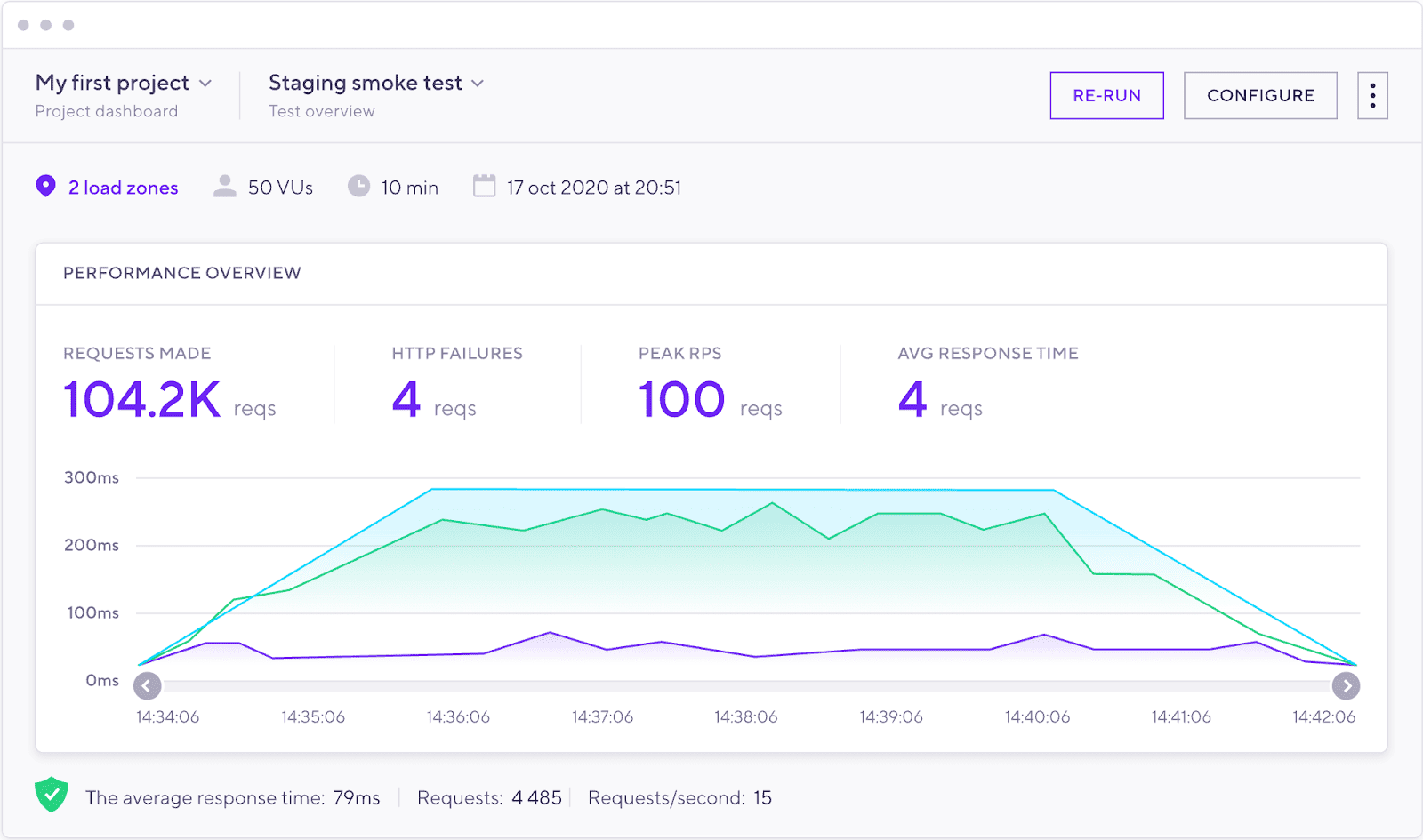When it comes to performance testing, LoadRunner is a familiar name — but it’s far from the only option. In this article, we’ll walk you through the best LoadRunner alternatives available today. If you’re scaling a new application, testing in an enterprise environment, or simply looking for more flexibility, read on to discover the load testing tools like LoadRunner that might suit your business better.
Comparison Table of LoadRunner Competitors
Choosing between the many LoadRunner competitors can be challenging—each tool offers different features, pricing models, and levels of support. To help you find the right performance testing solution for your business, we’ve compiled a side-by-side comparison of the most relevant LoadRunner alternatives so you can find a website load testing tool that would suit your needs. For those using Gatling and considering a switch, our guide to Gatling alternatives highlights tools that could be a better fit for your testing goals.
PFLB
PFLB is a cloud-based performance engineering platform tailored for businesses that can’t afford failure under pressure. Designed as an enterprise-grade LoadRunner alternative, it combines high configurability with ease of use — no-code scripting, smart scenario generation, and a user-first dashboard make it ideal for both QA teams and DevOps environments. As one of the most modern load testing tools like LoadRunner, it’s built to handle real-world stress simulations at scale. PFLB also allows running JMeter tests in the cloud, making it easier to scale your testing efforts without infrastructure overhead.
Also, read how PFLB compares to legacy tools in JMeter vs LoadRunner
Key Features
Unique Advantages
Unlike many LoadRunner competitors, PFLB allows you to go from zero to full-scale test without any scripting knowledge. It’s built with UX in mind — great for testers, developers, and decision-makers. With support for modern protocols like gRPC and Kafka, it’s also a future-ready solution for complex distributed applications.
Comparison with LoadRunner
While LoadRunner remains a heavyweight in the field, PFLB provides a more agile and intuitive alternative. LoadRunner’s steep learning curve and reliance on legacy interfaces can slow teams down. In contrast, PFLB simplifies everything — setup, scripting, and scaling — without compromising depth. It’s especially suited for enterprises moving toward DevOps maturity.
Price
Starts at $50/month. Scalable plans available for businesses with higher throughput needs.
Apache JMeter
Apache JMeter is a widely-used open-source performance testing tool developed by the Apache Software Foundation. Initially created for testing web applications, it has grown into a versatile solution that supports functional, regression, and load testing for various applications and protocols. As one of the most popular LoadRunner alternatives, JMeter is often chosen by testers and developers looking for full control and customization. For teams evaluating broader options in this category, exploring the best API performance testing tools can provide valuable insights into platforms that excel in simulating high-load API scenarios and ensuring system resilience.
Key Features
Unique Advantages
JMeter stands out among LoadRunner alternative tools for its extensibility and zero cost. It’s ideal for technical users who want to build fully customized test plans with deep scripting capabilities. Thanks to its rich plugin support, it’s easy to adapt for unique testing needs in both small projects and large-scale enterprise environments.
Comparison with LoadRunner
Unlike LoadRunner’s commercial structure and GUI-heavy workflows, JMeter is completely open-source and script-driven. It provides more flexibility and automation options for developer-centric teams but lacks the polished UI, built-in analytics, and enterprise support that tools like LoadRunner or PFLB offer. For teams with technical expertise, though, it remains one of the best LoadRunner alternatives available.
Price
Free and open-source under the Apache License 2.0.
Tricentis NeoLoad

NeoLoad, developed by Tricentis, is an advanced load testing tool built specifically for complex, large-scale enterprise applications. Positioned as a modern LoadRunner alternative, NeoLoad emphasizes automation, scalability, and seamless collaboration across DevOps and QA teams. It’s designed for organizations that need to test high-load systems like ERP, CRM, and internal platforms under continuous delivery conditions.
Key Features
Unique Advantages
What sets NeoLoad apart from other LoadRunner competitors is its blend of technical depth and team-focused usability. It reduces the time spent updating test scripts as applications evolve—a common pain point in performance testing. It’s particularly well-suited for regulated industries and global enterprises with mission-critical applications, where applying dynamic data masking techniques for compliance is essential to safeguard sensitive test data without disrupting test accuracy.
Comparison with LoadRunner
Both NeoLoad and LoadRunner cater to the enterprise segment, but NeoLoad’s automation-first approach gives it an edge for agile and DevOps environments. When evaluating LoadRunner or NeoLoad for performance testing, it’s worth noting that LoadRunner still holds strong in legacy protocol coverage, but NeoLoad’s continuous testing features and easier integration make it a compelling solution for modern businesses.
Price
Custom pricing based on virtual user volume and deployment type.
BlazeMeter
BlazeMeter is a cloud-based continuous testing platform that extends and enhances popular open-source tools like JMeter, Gatling, and Selenium. It’s a popular LoadRunner alternative for teams looking to scale existing test practices into fully integrated DevOps workflows. BlazeMeter enables full-service performance, API, and UI testing—suited for fast-moving teams who need flexibility, speed, and visibility.
Key Features
Unique Advantages
BlazeMeter’s power lies in its hybrid approach — combining open-source familiarity with enterprise-grade infrastructure and reporting. Among LoadRunner alternative tools, it’s one of the few that allows you to reuse your existing open-source tests at scale. The intuitive web interface and fast provisioning make it ideal for businesses needing rapid feedback and test execution across distributed teams. To help you compare your options, we’ve put together a dedicated post on BlazeMeter alternatives that explores tools with similar capabilities and different strengths.
Comparison with LoadRunner
LoadRunner can be heavy to manage and slower to adapt in fast-paced pipelines. BlazeMeter removes these blockers by offering on-demand cloud testing and strong CI support. While LoadRunner may offer broader protocol support, BlazeMeter excels in simplicity, developer adoption, and openness—key needs for modern application teams and agile enterprises.
Price
Subscription-based, with pricing tiers depending on usage and user count. Free tier available for small-scale testing.
k6
k6 is an open-source load testing tool purpose-built for developers. It enables performance testing using JavaScript, making it easy to create and version control test scripts alongside your application code. Lightweight and scriptable, k6 is one of the more modern LoadRunner alternatives optimized for automation, observability, and infrastructure-as-code environments.
Key Features
Unique Advantages
What makes k6 stand out among LoadRunner competitors is its dev-centric mindset. It fits naturally into a codebase, is version-controllable, and supports metrics output that aligns with modern observability stacks. It’s a great solution for engineering teams that treat performance as code and want a highly customizable tool without bloat.
Comparison with LoadRunner
LoadRunner takes a GUI-heavy, enterprise-first approach, while k6 is minimal, API-focused, and automation-ready. For businesses prioritizing developer productivity and integration with modern monitoring systems, k6 offers a compelling alternative—especially for microservices and cloud-native applications.
Price
WebLOAD
WebLOAD by RadView is a comprehensive performance testing platform geared toward enterprise use cases. With strong protocol coverage and support for complex transactional flows, WebLOAD is a reliable LoadRunner alternative for testing business-critical applications across industries like banking, telecom, and e-commerce. It’s best suited for teams needing deep scripting flexibility and a familiar on-premise environment.
Key Features
Unique Advantages
WebLOAD appeals to businesses running legacy systems alongside modern web apps. It offers strong support for complex test scenarios involving multiple protocols and user behaviors. Among LoadRunner competitors, it’s one of the few that balance depth with mature reporting and real-time control.
Comparison with LoadRunner
Both WebLOAD and LoadRunner serve the enterprise market, but WebLOAD often offers a smoother user experience with less overhead and a more transparent pricing model. LoadRunner may have broader protocol coverage, but WebLOAD wins points for usability and faster ramp-up for performance teams.
Price
Custom licensing based on the number of virtual users and deployment environment. Free trial available.
LoadView
LoadView is a fully managed, cloud-based load testing tool focused on real browser testing. It allows teams to simulate user interactions in actual browser environments, making it one of the most intuitive LoadRunner alternatives for validating user experience under load. With its visual scripting interface, LoadView is ideal for teams who want results fast — without writing code.
Key Features
Unique Advantages
Unlike more code-heavy LoadRunner competitors, LoadView is made for speed and simplicity. It’s especially useful when validating customer-facing applications, like e-commerce platforms or SaaS dashboards, where real browser behavior matters. Teams can launch tests quickly without engineering overhead.
Comparison with LoadRunner
Where LoadRunner is heavy on scripting and protocol-level simulation, LoadView focuses on high-fidelity UI testing through actual browsers. It’s less technical, more visual, and far quicker to get up and running — ideal for smaller businesses, marketing teams, or QA groups that don’t want to manage infrastructure.
Price
Pay-as-you-go pricing bas
StresStimulus

StresStimulus is a performance and stress testing tool tailored specifically for web and mobile applications, with deep support for complex user scenarios. It’s a Windows-based LoadRunner alternative that captures and replicates real user interactions, making it particularly effective for teams focused on end-to-end business flows rather than raw traffic generation.
Key Features
Unique Advantages
Among LoadRunner competitors, StresStimulus stands out for its ease of use and strong support for correlation-heavy, session-based web apps. It’s particularly valuable for businesses working in Microsoft ecosystems or those needing to validate login flows, e-commerce carts, or multi-step forms under load.
Comparison with LoadRunner
While LoadRunner offers broader protocol coverage and enterprise integrations, StresStimulus provides a lighter, more accessible experience for teams focused on web tech stacks. It’s also easier to onboard, script, and maintain, especially for small to mid-size enterprises looking for fast results.
Price
Perpetual and subscription licenses available. Pricing depends on concurrent virtual users and deployment type. Free trial offered.
SmartMeter.io

SmartMeter.io is a JMeter-compatible load testing tool that enhances the open-source framework with enterprise-grade features like real-time test monitoring, advanced reporting, and automated CI/CD integration. It’s a smart, code-optional LoadRunner alternative built for teams that want the flexibility of JMeter without the usual setup overhead.
Key Features
Unique Advantages
SmartMeter.io sits in a sweet spot between raw open-source tools and full-blown commercial platforms. It’s one of the most approachable LoadRunner alternative tools for teams that want JMeter’s power with better UX and built-in analytics. It also requires less manual configuration, making it ideal for agile businesses that need fast turnaround on performance insights.
Comparison with LoadRunner
Compared to LoadRunner, SmartMeter.io is more lightweight, easier to maintain, and simpler to integrate into automated workflows. While LoadRunner may have deeper protocol support and vendor backing, SmartMeter.io delivers a flexible, developer-friendly solution at a much lower cost.
Price
Commercial licenses available with various tiers based on users and features. Free trial includes full feature access for a limited time.
Locust
Locust is an open-source performance testing framework written in Python, designed for developers who want full control over their load testing scenarios. As a lightweight, code-driven LoadRunner alternative, Locust makes it easy to write, read, and scale test scripts while offering excellent flexibility for modern microservice and API testing.
Key Features
Unique Advantages
Locust stands out among LoadRunner competitors for its simplicity and clarity—test plans are Python classes, not complex GUIs or XML files. It’s especially suited for agile teams or tech-savvy businesses that want to embed performance tests directly into their CI/CD process. Its scalability and scripting flexibility also make it ideal for testing cloud-native applications.
Comparison with LoadRunner
LoadRunner leans heavily on UI-based workflows and broader protocol coverage, while Locust is all about writing scalable, human-readable test logic as code. It’s a more minimalist, open-source solution tailored to fast-moving dev teams rather than traditional QA departments.
Price
Free and open-source under the MIT license. Requires setup and Python knowledge.
PFLB is the Best LoadRunner Alternative
Among the various LoadRunner alternatives, PFLB distinguishes itself by offering a modern, purpose-built platform designed to meet the demands of both enterprise-scale systems and agile development environments.
Key Benefits
Related insights in blog articles
Why Averages Lie: Mathematical Methods for Load Testing

Relying on “average” metrics alone makes load testing surprisingly inaccurate. In this article, we’ll show how to avoid the usual traps and walk through practical techniques for mathematically modelling a workload profile, from analyzing variance and correlations to spotting Simpson’s paradox and validating the final model. When a company moves to a new system, the […]
DevDays Europe Conference 2026 – Advance Your Software Development Expertise

DevDays Europe is the ultimate software development conference that aims to bring together the brightest minds and innovators in the software development community. Join the conference for an immersive experience filled with transformative insights, collaborative opportunities, and the latest cutting-edge technology. The DevDays Europe 2024 will be happening both on-site and online, allowing everyone to join the event in their preferred format.
UI Load Testing: Full Guide

When an application starts to slow down, users notice it immediately. Pages hesitate to load, buttons lag, animations freeze for a split second, and that’s often enough to make someone close the tab. These issues rarely come from the backend alone. In most cases, the real strain appears in the browser, where scripts, styles, and […]
Internet of Things Testing: Benefits, Best Practices, & Tools for Reliable Connected Systems

IoT is an ecosystem of devices connected through networks and relying on cloud or app services for endless communication, data exchange, and smart automation. For this ecosystem to work seamlessly 24/7, it heavily depends on IoT testing. Apart from impeccable performance, the latter guarantees the reliability, protection, and integrity of diverse devices, networks, apps, and […]
Be the first one to know
We’ll send you a monthly e-mail with all the useful insights that we will have found and analyzed
People love to read
Explore the most popular articles we’ve written so far
- Top 10 Load Testing Tools for 2025: The Deep Dive Sep 9, 2025
- Cloud-based Testing: Key Benefits, Features & Types Dec 5, 2024
- Benefits of Performance Testing for Businesses Sep 4, 2024
- Android vs iOS App Performance Testing: What’s the Difference? Dec 9, 2022
- How to Save Money on Performance Testing? Dec 5, 2022











